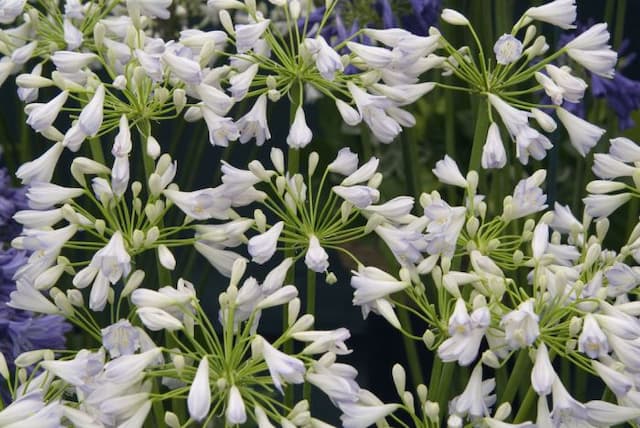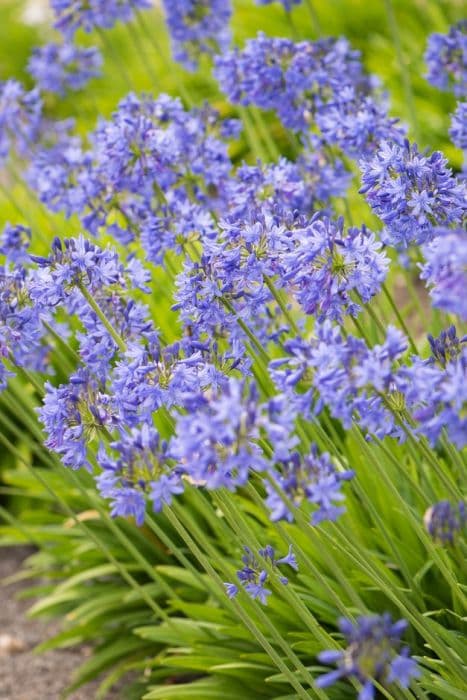African Lily Agapanthus 'Sandringham'

ABOUT
Agapanthus 'Sandringham' is a striking ornamental plant, known commonly as the Lily of the Nile or African lily, though it is not a true lily. It boasts lush, strap-shaped green leaves that form a dense clump, offering a backdrop to its most distinctive feature: the flowers. These blooms are typically arranged in impressive spherical clusters, known as umbels, at the top of stiff, upright stalks that rise gracefully above the foliage clump. The flowers themselves are trumpet-shaped, with a narrow base that flares out into a wider rim. Each individual bloom is resplendent, commonly appearing in a soothing shade of blue that can range from a pale, soft hue to a deeper, more vibrant azure. These clusters of blue flowers create a dramatic visual impact that can give a garden a focal point of cool color, especially during their blooming season. In addition to its blue variants, the Lily of the Nile can also sport flowers in shades of white and purple, with the 'Sandringham' variety being particularly noted for its coloration. The overall effect of the plant when in bloom is both elegant and eye-catching, making it a popular choice for gardeners looking to add a touch of sophistication to a garden bed or border. Although not mentioned, the plant size can influence how it fits into a landscape, but regardless of its actual dimensions, the spectacular floral display and attractive foliage of the Agapanthus 'Sandringham' can make it a noteworthy addition to any suitable garden setting.
About this plant
 Names
NamesFamily
Amaryllidaceae.
Synonyms
African Lily, Lily of the Nile, Love Flower.
Common names
Agapanthus 'Sandringham'
 Toxicity
ToxicityTo humans
The Agapanthus, commonly known as the Lily of the Nile, contains compounds that can be toxic if ingested. It can cause gastrointestinal symptoms such as nausea, vomiting, and diarrhea. Additionally, skin contact with the sap may result in irritation or allergic reactions for sensitive individuals. Ingesting parts of this plant, particularly in large amounts, can lead to more severe symptoms and should be avoided.
To pets
The Agapanthus, known as the Lily of the Nile, is also toxic to pets, including dogs and cats. If pets consume any part of the plant, they may experience symptoms such as nausea, vomiting, and diarrhea. In more serious cases, it could lead to tremors or increase in heart rate. Pet owners should prevent their animals from ingesting this plant to avoid these potential health issues.
 Characteristics
CharacteristicsLife cycle
Perennials
Foliage type
Evergreen
Color of leaves
Green
Flower color
Blue
Height
2 feet [60 cm]
Spread
2 feet [60 cm]
Plant type
Bulb
Hardiness zones
8
Native area
South Africa
Benefits
 General Benefits
General Benefits- Ornamental Appeal: The Agapanthus 'Sandringham', commonly known as Lily of the Nile, adds aesthetic value to gardens with its tall, striking flower spikes and attractive foliage.
- Drought Tolerance: Once established, the Lily of the Nile is relatively drought-resistant, making it suitable for water-conserving landscapes.
- Low Maintenance: This plant requires minimal care once settled in its preferred growing conditions, making it ideal for gardeners of all levels.
- Attracts Pollinators: Its blossoms attract bees, butterflies, and other beneficial insects, which are important for pollination and the overall health of the garden.
- Long Blooming Season: The Lily of the Nile typically has a long flowering period that lasts throughout the summer, providing continual color in the garden.
- Versatility: The plant can be used in a variety of settings, including borders, containers, and as a focal point in flower beds.
- Tolerates Different Soil Types: While it prefers well-drained soil, Lily of the Nile can tolerate a range of soil conditions, making it adaptable to different garden environments.
- Perennial Growth: As a perennial plant, it returns year after year, offering a reliable element to garden design without the need for replanting annually.
- Deer Resistance: Its foliage and flowers are not particularly palatable to deer, reducing the likelihood of damage in areas where deer are a common problem.
- Coastal Garden Suitability: The Agapanthus 'Sandringham' is salt-tolerant and can thrive in coastal gardens where other plants may struggle.
 Medical Properties
Medical PropertiesThis plant is not used for medical purposes.
 Air-purifying Qualities
Air-purifying QualitiesThis plant is not specifically known for air purifying qualities.
 Other Uses
Other Uses- Flower Photography: The Agapanthus 'Sandringham', commonly known as African Lily, produces stunning blue or purple flowers that are ideal subjects for macro and nature photography due to their intricate structure and vibrant color.
- Dye Production: The vibrant blue and purple hues of the African Lily petals can be used to create natural dyes for textiles, offering a sustainable option for fabric coloring.
- Educational Tool: Botany students can study the African Lily for understanding plant morphology and reproductive systems, as it has distinct floral arrangements that aid in learning about monocot flowering plants.
- Culinary Garnish: While not commonly eaten, the petals of the African Lily can be used as an ornamental garnish for high-end culinary dishes, providing an exotic and colorful touch.
- Artistic Inspiration: The unique appearance of the African Lily can inspire artists and designers, who may incorporate its form and color into various mediums such as painting, textile design, and even architecture.
- Event Decor: The long-lasting flowers and leaves of the African Lily could be used in floral arrangements for events, offering both elegance and durability throughout celebrations.
- Companion Planting: The African Lily can be used in gardens to accompany other plants; its tall structure allows it to pair well with low-growing, sun-loving plants, creating a layered garden design.
- Habitat Support: When planted outdoors, the African Lily can provide a habitat for beneficial insects, such as bees and butterflies, which are attracted to its flowers' nectar and pollen.
- Feng Shui: Some practitioners use the African Lily in their feng shui arrangements, believing it brings a sense of calm and tranquility to a space due to its soothing color and flowing shape.
- Craft Material: Dried African Lily flowers can be utilized in making crafts such as bookmarks, greeting cards, or potpourri, adding a natural and decorative element to homemade projects.
Interesting Facts
 Feng Shui
Feng ShuiThe Lily of the Nile is not used in Feng Shui practice.
 Zodiac Sign Compitability
Zodiac Sign CompitabilityThe Lily of the Nile is not used in astrology practice.
 Plant Symbolism
Plant Symbolism- Love Letters: The Agapanthus, commonly known as the African Lily or Lily of the Nile, is often associated with love and can symbolize a letter or message of love due to its funnel-shaped blossoms reminiscent of the shape of a rolled parchment.
- Beauty: The striking blue or purple flowers of the African Lily are regarded as a symbol of beauty and elegance, reflecting the plant's attractive and stately appearance.
- Fertility: With its lush foliage and abundant flowers, the African Lily can represent fertility and abundance, as it often blooms profusely in the right conditions.
- Home: Because Agapanthus can thrive in many conditions and is often planted to border homes, it symbolizes the protection and safety of a house, symbolizing a sanctuary or homecoming.
- Enduring Love: The perennial nature of the African Lily, which returns year after year, can symbolize enduring or long-lasting love.
 Water
WaterLily of the Nile should be watered deeply once a week during the growing season, ensuring that the soil is moist but well-draining. Typically, one to two gallons per plant for each watering session is sufficient, depending on the size of the plant and the environmental conditions. Cut back on watering in the winter when the plant is dormant, reducing to half a gallon every two weeks to prevent the soil from drying out completely. Overwatering can lead to root rot, so it's essential to let the soil dry out slightly between watering sessions.
 Light
LightLily of the Nile thrives best in full sun to partial shade. The ideal spot for this plant would be where it can receive at least six hours of direct sunlight daily. However, in extremely hot climates, some afternoon shade can help protect the plant from intense heat.
 Temperature
TemperatureLily of the Nile can generally tolerate temperatures as low as 25 degrees Fahrenheit, but it prefers a range between 50 and 80 degrees Fahrenheit for optimal growth. It is not frost-tolerant and should be protected or brought indoors if temperatures are expected to drop below the minimum threshold.
 Pruning
PruningPrune Lily of the Nile after flowering to remove spent blooms and encourage a tidy appearance. Deadheading the flowers as they fade can also promote a second bloom period. The best time for major pruning is in early spring before new growth begins, which generally means cutting back any damaged or old foliage.
 Cleaning
CleaningAs needed
 Soil
SoilThe ideal soil mix for Agapanthus, also known as African Lily, is a well-draining mix with loamy or sandy soil enriched with compost or organic matter. The soil pH should range between 6.0 and 8.0. It is essential to ensure adequate drainage to prevent root rot, which can be a common issue with African Lilies if the soil retains too much moisture.
 Repotting
RepottingAfrican Lilies should be repotted every 2 to 4 years to refresh the soil and accommodate root growth. However, they bloom best when slightly root-bound, so it's important not to repot too frequently or to use a pot that is disproportionately large.
 Humidity & Misting
Humidity & MistingAfrican Lilies prefer moderate humidity but are quite adaptable to different humidity levels as long as they are not in excessively dry conditions. They tolerate normal household humidity levels well, making them suitable for most indoor environments.
 Suitable locations
Suitable locationsIndoor
Ensure bright light, well-draining soil, and occasional feeding.
Outdoor
Plant in full sun to partial shade, in fertile, well-drained soil.
Hardiness zone
6-10 USDA
 Life cycle
Life cycleThe life of an Agapanthus, commonly known as Lily of the Nile or African lily, begins with seed germination, occurring in warmer conditions with consistent moisture. Following germination, the seedlings establish a root system and send up shoots, entering the vegetative growth phase where foliage development is the main focus. As the plant matures, it enters the flowering stage, usually in summer, producing distinctive globe-shaped clusters of blue or purple flowers atop long, sturdy stalks. After pollination, which is often facilitated by insects, the flowers give way to seed pods that mature and eventually release seeds, completing the reproductive cycle. If conditions are not conducive to seeding, Agapanthus can also propagate vegetatively via division of its rhizomatous root system, ensuring its spread and survival. During the winter or cooler months, especially in non-tropical climates, the plant may enter a dormancy period, with growth and metabolic activity significantly reduced.
 Propogation
PropogationPropogation time
Spring-Early Summer
The most popular method of propagation for Agapanthus 'Sandringham', commonly known as the African Lily, is by dividing the plant's clumps, typically undertaken during the spring or early summer. Once the plant has become crowded, usually every 3 to 4 years, it should be lifted from the ground with care not to damage the roots. The gardener should then tease apart the individual clumps by hand or carefully with a knife, making sure that each division has at least one to two healthy shoots and a portion of the root system. These divisions can then be replanted into well-draining soil, spaced approximately 12 to 18 inches (30 to 45 centimeters) apart, ensuring that they are planted at the same depth they were growing previously. This method allows for a straightforward and effective way to produce new plants that will usually bloom within a year or two.









